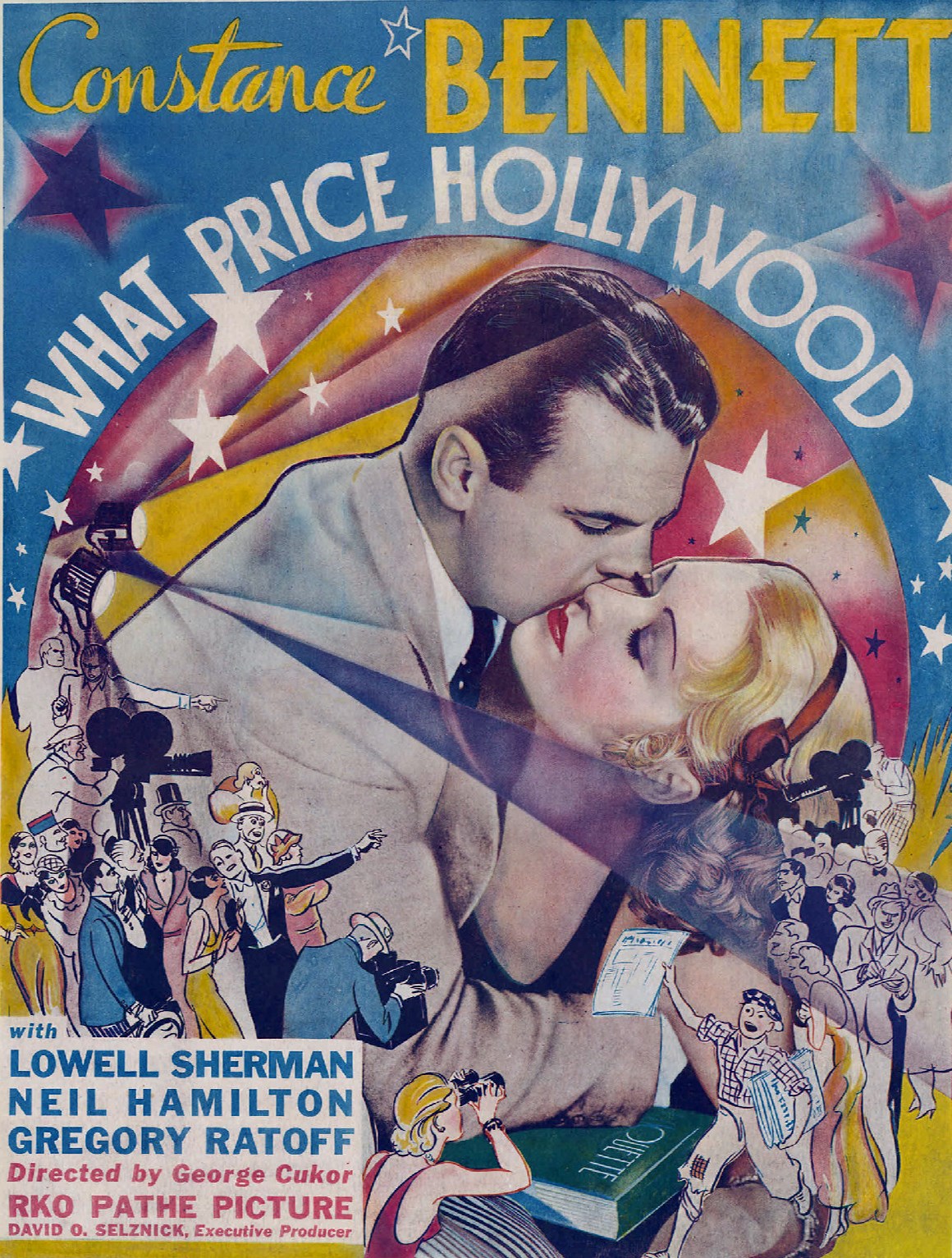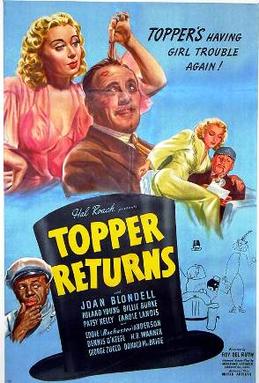Bradley Cooper is reportedly directing a remake of A Star Is Born in which he and Lady Gaga will take the roles played by Fredric March and Janet Gaynor in 1937, James Mason and Judy Garland in 1954, and Kris Kristofferson and Barbra Streisand in 1976. So maybe it's a good time to check out the ur-Star Is Born, What Price Hollywood?, that was produced by David O. Selznick and directed by George Cukor in 1932. The name is different but the plot's the same: A successful man in the entertainment business discovers a young woman whom he helps become a star, but as her career ascends, his personal problems send him into a tailspin.* The idea for the film is a natural in a Hollywood that had become increasingly conscious of its own myth, and many real-life analogs have been found in the history of the industry. Selznick commissioned Adela Rogers St. Johns, a former reporter for Photoplay and the Hearst newspapers, to write the story for the film, and various other hands turned it into a screenplay, though St. Johns and Jane Murfin claimed most of the credit when they were nominated for an Oscar for best original story. The film begins with a touch of screwball comedy when Max Carey (Lowell Sherman), an alcoholic director, encounters Mary Evans (Constance Bennett), a waitress at the Brown Derby looking for her chance to break into the movies. After some funny scenes involving Max's drunkenness and Mary's initial ineptness as an actress, the movie unfortunately begins to get serious. Though it's clear Mary really loves Max, when she becomes a big star she marries a society polo player, Lonny Borden (Neil Hamilton), after a somewhat cutesy courtship. But Borden is unhappy being "Mr. Mary Evans," and eventually storms out, though she's pregnant. Meanwhile, Max's decline continues, and after Mary rescues him from the drunk tank and promises to rehabilitate him, he shoots himself, thereby embroiling her in a headline-making scandal. But then Borden returns to apologize and all is well again. What keeps the film alive despite its clichés are the performances. Bennett is quite charming, and Sherman clearly models Max on John Barrymore, whom he knew well: He was married to Helene Costello, whose sister, Dolores, was Barrymore's third wife. The supporting cast includes Gregory Ratoff as the producer of Mary's films, Louise Beavers as (of course) her maid, and Eddie Anderson as Max's chauffeur -- five years before he became famous as Jack Benny's chauffeur, Rochester, on radio.
*As if there were any doubt, there's a clear link between What Price Hollywood? and at least the first A Star Is Born in that both were produced by Selznick. RKO, which released What Price Hollywood?, threatened to sue Selznick over the similarities, but decided against it. Selznick also asked Cukor to direct the 1937 film, but Cukor declined, so William A. Wellman took it on. But then Cukor went on to direct the 1954 Star Is Born. I don't think there's any direct connection between What Price Hollywood? and the 1976 version, produced by Streisand and Jon Peters and directed by Frank Pierson, but the lineage by then was obvious.
A blog formerly known as Bookishness / By Charles Matthews
"Dazzled by so many and such marvelous inventions, the people of Macondo ... became indignant over the living images that the prosperous merchant Bruno Crespi projected in the theater with the lion-head ticket windows, for a character who had died and was buried in one film and for whose misfortune tears had been shed would reappear alive and transformed into an Arab in the next one. The audience, who had paid two cents apiece to share the difficulties of the actors, would not tolerate that outlandish fraud and they broke up the seats. The mayor, at the urging of Bruno Crespi, explained in a proclamation that the cinema was a machine of illusions that did not merit the emotional outbursts of the audience. With that discouraging explanation many ... decided not to return to the movies, considering that they already had too many troubles of their own to weep over the acted-out misfortunes of imaginary beings."--Gabriel García Márquez, One Hundred Years of Solitude
Search This Blog
Showing posts with label Eddie Anderson. Show all posts
Showing posts with label Eddie Anderson. Show all posts
Wednesday, April 19, 2017
Saturday, April 15, 2017
Topper Returns (Roy Del Ruth, 1941)
This silly B-picture was just the thing to unwind with after the heaviness of the last couple of posts. It's the second of two sequels to the original Topper (Norman Z. McLeod, 1937), about a stuffy banker beset by sexy ghosts. But it doesn't have much in common with the first movie other than Roland Young as Topper and Billie Burke as his fluttery, suspicious wife who mistakes his odd behavior for infidelity when the ghosts start teasing him. Cary Grant and Constance Bennett were the mischievous ghosts in the first film, but Grant jumped ship before the first sequel, Topper Takes a Trip (McLeod, 1938), after which Bennett bailed out too. This time the sexy ghost is Joan Blondell, whose character, Gail Richards, is murdered by mistake: The intended victim was her friend, Ann Carrington (Carole Landis), heir to a large fortune. Once she passes over, the ectoplasmic Gail enlists Topper, of all people, in helping solve her murder. Young is, as always, a delight -- one of the greatest comic actors ever to be underemployed by Hollywood -- but he doesn't have a lot to do this time except be shoved around by the invisible Gail as they search for clues in the creepy mansion where she was murdered. Mrs. Topper shows up, too, accompanied by her maid (Patsy Kelly) and the chauffeur, played by Eddie Anderson, billed as Eddie "Rochester" Anderson because of his fame as the eponymous chauffeur on Jack Benny's radio show. Even though he's called "Eddie" by Topper and "Edward" by Mrs. Topper, he manages to slip in a line about how he wants his old job with Mr. Benny back. Although Anderson is given some stereotypical moments predicated on the old gag that black people are afraid of ghosts, and there's a tedious slapstick bit involving a sea lion (oh, don't ask), he's treated as more of a comic equal in the film than African American actors usually were, matching wisecrack for wisecrack. There are also some funny moments with Donald MacBride as a particularly addled police detective. The whole thing is laced through with topical gags that have lost their edge: Rafaela Ottiano plays a sinister housekeeper modeled on Mrs. Danvers in Rebecca (Alfred Hitchcock, 1940), and if you don't get the joke immediately be sure that someone will refer to her as "Rebecca," even though her character's name is Lillian. The movie is also a reminder of how pervasive radio once was in popular culture: In addition to Anderson's reference to Jack Benny, there are also quips about Orson Welles's "War of the Worlds" broadcast, and a radio giveaway show called "Pot o' Gold" in which people won the jackpot if they answered their randomly dialed telephone.
Subscribe to:
Comments (Atom)

